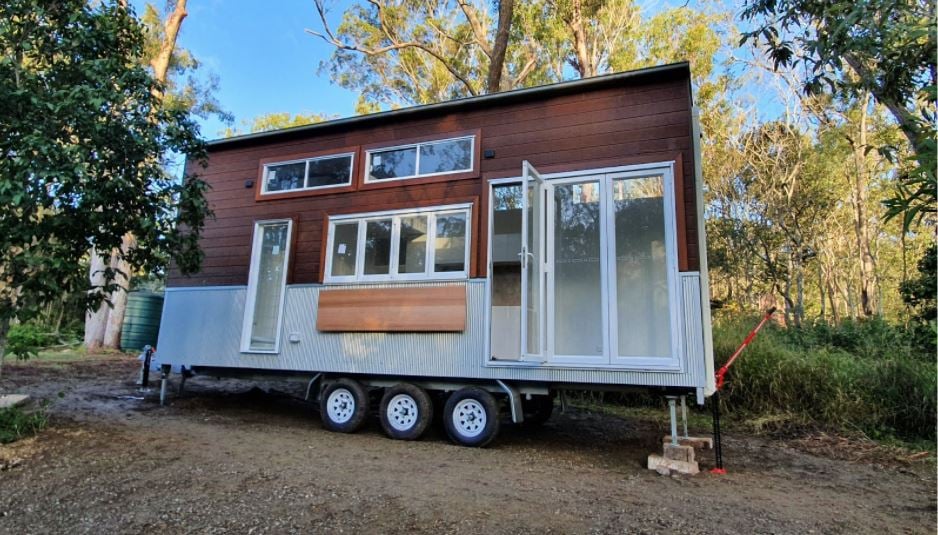How can I connect power and water to a tiny home?

Tiny homes have the flexibility to obtain water and electricity through either traditional utility connections or by running off the grid. Which option you go with really depends on the purpose of your tiny house.
If you plan to position a tiny home close to your ‘main’ house to use as a studio, home office or spare bedroom, then you can easily power it just as you would a caravan or RV, by running an extension cord from your home to the tiny home. The same goes with water which can be supplied through a quality garden hose.
Most tiny homes come standard with a composting toilet. However, you do have the option of plumbing in a macerating toilet if that’s what you’d prefer. These types of toilets function much the same as a traditional flushing toilet but require both full plumbing and an electrical hook up.
You may however want the flexibility to move your tiny house to different areas of your block, away from the main house, especially if your plan is to use it as an Airbnb, farmstay, granny flat or a holiday rental. If that’s the case, then the off-grid option may suit you better.
Let’s take a closer look at both traditional and off-grid water and electricity options to help you decide which might be best for your tiny home.
Hooking up your tiny home to standard power
Perhaps you’re setting up your tiny house to use as a granny flat for a member of the family, or as an office or creative space. In that case, you may prefer it to be closer to your house and simply plug in to your existing power.
Check that the electricity cord you choose is sized correctly according to your power requirements and amp service. Depending on how you plan to use your tiny home, you may only need 120 amp. If you require more power, you can hook up 240 amps instead.
You need to carefully consider the safety aspects of running a cord from your home. It would be wise to seek professional advice to ensure both your big house and tiny home are kept safe, as well as the people in them!
This option may be a good place to start. You can always shift later to making your tiny home more self-sufficient by generating its own power through solar panels.
Choosing off-grid power for your tiny house
Going off-grid is a popular choice for tiny homeowners. It allows more flexibility, saves you money in the long run and is kinder to the planet.
There’s another, rather unique benefit of installing solar panels. As your tiny home is on wheels, you can move it to different positions and take full advantage of the sun’s power.
Unlike your larger home, the solar panels on a tiny home don’t need to be just on the roof. You can have them set up separately on a trailer giving you even more flexibility. Imagine in the heat of summer, popping your tiny home under a leafy tree so it stays cooler, while the panels sit outside gathering energy. For cloudy days, you can invest in a small generator to give your tiny home plenty of power. If you also invest in smart appliances, it won’t cost very much at all to run your tiny home.
Make sure if choosing solar to carefully consider where to place the battery pack and inverter. They can be bulky and sometimes make noise, so many people choose to mount them in a box outside.
Running water from your house to your tiny home
Just like the mains electricity option, this could be an easy place to start, especially if your water needs are low or while you’re deciding where to position your tiny home.
If you plan to use it as an office or studio and don’t mind popping into the house to use the loo, then you may only need water to boil the kettle. In that case, a garden hose will do.
If your focus is more commercial such as renting out your tiny home through Airbnb or as a guest house, you will want a more permanent and reliable water supply. Even as a granny flat, your granny won’t be happy with the garden hose arrangement for very long!
Having a self-sufficient water supply for your tiny home
If you want your tiny home to be completely self-sufficient and off-grid, then a water tank is the way to go. You can easily have gutters, a tank and filtration system fitted to collect and store rainwater. If you live in a low rainfall area, then of course you will need to consider other options.
Once again, fitting your tiny house with water-saving devices will help, no matter where your water supply comes from.
Ready to talk tiny?
Everyone has a different vision for their tiny home. Just when we think we’ve heard them all, along comes a new one and we’re all ears! We love to talk tiny, discover your ideas and share some of ours.
We offer completed tiny houses that are delivered to your block, ready to move in or start renting out to your holiday guests.
Have a look through our selection of designs which you can choose from, or we can create someting completely customised for your needs if you prefer.
Contact us today. We would love to help you go tiny!

